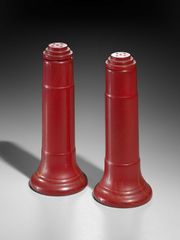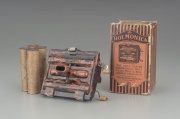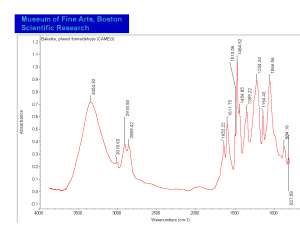Difference between revisions of "Bakelite"
| (6 intermediate revisions by the same user not shown) | |||
| Line 1: | Line 1: | ||
| − | [[File:1984.311.1-6-SC34181.jpg|thumb|]] | + | [[File:Bakelite2010488.1-2.jpg|thumb|Bakelite shakers<br>MFA# 2010.488.1-2]] |
| + | [[File:1984.311.1-6-SC34181.jpg|thumb|Bakelite Rolmonica<br>MFA# 1984.311.1]] | ||
== Description == | == Description == | ||
| − | [Dow Chemical] Trademark name for a series of thermosetting synthetic resins. The original Bakelite synthetic resin, composed of [[phenol%20formaldehyde%20resin|phenol formaldehyde]], was discovered in 1907 by Dr. Leo Baekeland. It was a hard, thermosetting polymer that was resistant to water, oils, and solvents. The original Bakelite polymer was also a poor conductor of electricity and for the first 10 years of production, the company primarily made electrical insulators. From the 1920s - 40s, the dark-color, phenolic resin was used to make molded articles such as radio cabinets, telephone receivers, costume jewelry, dishes, and other household items. It was also used to laminate paper and fabric and to make imitation amber. Early Bakelite products were made in 5 colors (yellow, butterscotch, brown, green, and red) along with mixtures forming marbleized patterns. In 1927, the Bakelite patent expired and competing companies, such as [[Catalin]], began selling colorful cast phenolic resin products. Soon Bakelite also introduced a colorful line of cast products called Bakelite cast resin. In 1939, the Bakelite Company merged with Union Carbide. During the early 40s, only black products were made because of the war. Since 1975, the term Bakelite has been used by Union Carbide (then Dow since 2001) for a series of molded polymers and adhesives that are composed of the following resins: [[polyethylene]] (Bakelite DQDE), [[polypropylene]], [[epoxy]] (Bakelite RD), [[phenolic%20resin|phenolic]], [[polystyrene]] (Bakelite RMD), [[phenoxy%20resin|phenoxy]], [[polysulfone]], [[acrylonitrile%20butadiene%20styrene | + | [Dow Chemical] Trademark name for a series of thermosetting synthetic resins. The original Bakelite synthetic resin, composed of [[phenol%20formaldehyde%20resin|phenol formaldehyde]], was discovered in 1907 by Dr. Leo Baekeland. It was a hard, thermosetting polymer that was resistant to water, oils, and solvents. The original Bakelite polymer was also a poor conductor of electricity and for the first 10 years of production, the company primarily made electrical insulators. From the 1920s - 40s, the dark-color, phenolic resin was used to make molded articles such as radio cabinets, telephone receivers, costume jewelry, dishes, and other household items. It was also used to laminate paper and fabric and to make imitation amber. Early Bakelite products were made in 5 colors (yellow, butterscotch, brown, green, and red) along with mixtures forming marbleized patterns. In 1927, the Bakelite patent expired and competing companies, such as [[Catalin]], began selling colorful cast phenolic resin products. Soon Bakelite also introduced a colorful line of cast products called Bakelite cast resin. In 1939, the Bakelite Company merged with Union Carbide. During the early 40s, only black products were made because of the war. Since 1975, the term Bakelite has been used by Union Carbide (then Dow since 2001) for a series of molded polymers and adhesives that are composed of the following resins: [[polyethylene]] (Bakelite DQDE), [[polypropylene]], [[epoxy]] (Bakelite RD), [[phenolic%20resin|phenolic]], [[polystyrene]] (Bakelite RMD), [[phenoxy%20resin|phenoxy]], [[polysulfone]], [[acrylonitrile%20butadiene%20styrene|ABS]], [[acrylic%20resin|acrylic]], or [[vinyl%20resin|vinyl]] (Bakelites QYNV, VYLF, EVA, AYAC, AYAA). |
[[[SliderGallery rightalign|Bakelite FTIR.PNG~FTIR]]] | [[[SliderGallery rightalign|Bakelite FTIR.PNG~FTIR]]] | ||
| Line 8: | Line 9: | ||
== Synonyms and Related Terms == | == Synonyms and Related Terms == | ||
| − | Fireproof Celluloid [Damard Lacquer Co.]; Luxene (translucent); baquelita (Esp.); Catalin; Faturan | + | polyoxybenzylmethylenglycolanhydride; Fireproof Celluloid [Damard Lacquer Co.]; Luxene (translucent); baquelita (Esp.); Catalin; Faturan; Micarta |
| − | |||
| − | |||
| − | |||
| − | |||
== Comparisons == | == Comparisons == | ||
| − | [[media: | + | [[media:download_file_285.pdf|General Characteristics of Polymers]] |
| − | |||
| − | |||
| − | |||
| + | [[media:download_file_291.pdf|Physical Properties for Selected Thermoset Resins]] | ||
== Additional Images == | == Additional Images == | ||
| Line 29: | Line 24: | ||
</gallery> | </gallery> | ||
| − | + | == Resources and Citations == | |
| − | == | + | * [https://www.nps.gov/museum/publications/conserveogram/08-04.pdf Care and Identification of Objects Made from Plastic], Conserve O Gram 8/4, National Park Service, September 2010. |
| + | * Sharon Blank, "An introduction to plastics and rubbers in collections", ''Studies in Conservation'', 35, 1990, 53-63. | ||
* G.S.Brady, ''Materials Handbook'', McGraw-Hill Book Co., New York, 1971 Comment: p. 792 | * G.S.Brady, ''Materials Handbook'', McGraw-Hill Book Co., New York, 1971 Comment: p. 792 | ||
| Line 44: | Line 40: | ||
* Sharon Blank, An introduction to plastics and rubbers in collections, ''Studies in Conservation'', 35, 53-63, 1990 | * Sharon Blank, An introduction to plastics and rubbers in collections, ''Studies in Conservation'', 35, 53-63, 1990 | ||
| − | * Website | + | * Website: www.me.umist.ac.uk/historyp/history.htm |
| − | * Website | + | * Website: www.deco-echoes.com/bakelite.html |
| − | * Website | + | * Website: www.nswpmith.com.au/historyofplastics.html |
| − | * Website | + | * Website: www.n=mesothel.com (1975) |
[[Category:Materials database]] | [[Category:Materials database]] | ||
Latest revision as of 14:19, 6 December 2020
Description
[Dow Chemical] Trademark name for a series of thermosetting synthetic resins. The original Bakelite synthetic resin, composed of phenol formaldehyde, was discovered in 1907 by Dr. Leo Baekeland. It was a hard, thermosetting polymer that was resistant to water, oils, and solvents. The original Bakelite polymer was also a poor conductor of electricity and for the first 10 years of production, the company primarily made electrical insulators. From the 1920s - 40s, the dark-color, phenolic resin was used to make molded articles such as radio cabinets, telephone receivers, costume jewelry, dishes, and other household items. It was also used to laminate paper and fabric and to make imitation amber. Early Bakelite products were made in 5 colors (yellow, butterscotch, brown, green, and red) along with mixtures forming marbleized patterns. In 1927, the Bakelite patent expired and competing companies, such as Catalin, began selling colorful cast phenolic resin products. Soon Bakelite also introduced a colorful line of cast products called Bakelite cast resin. In 1939, the Bakelite Company merged with Union Carbide. During the early 40s, only black products were made because of the war. Since 1975, the term Bakelite has been used by Union Carbide (then Dow since 2001) for a series of molded polymers and adhesives that are composed of the following resins: Polyethylene (Bakelite DQDE), Polypropylene, Epoxy (Bakelite RD), phenolic, Polystyrene (Bakelite RMD), phenoxy, Polysulfone, ABS, acrylic, or vinyl (Bakelites QYNV, VYLF, EVA, AYAC, AYAA).
Synonyms and Related Terms
polyoxybenzylmethylenglycolanhydride; Fireproof Celluloid [Damard Lacquer Co.]; Luxene (translucent); baquelita (Esp.); Catalin; Faturan; Micarta
Comparisons
General Characteristics of Polymers
Physical Properties for Selected Thermoset Resins
Additional Images
Resources and Citations
- Care and Identification of Objects Made from Plastic, Conserve O Gram 8/4, National Park Service, September 2010.
- Sharon Blank, "An introduction to plastics and rubbers in collections", Studies in Conservation, 35, 1990, 53-63.
- G.S.Brady, Materials Handbook, McGraw-Hill Book Co., New York, 1971 Comment: p. 792
- Richard S. Lewis, Hawley's Condensed Chemical Dictionary, Van Nostrand Reinhold, New York, 10th ed., 1993
- Dictionary of Building Preservation, Ward Bucher, ed., John Wiley & Sons, Inc., New York City, 1996
- Thomas C. Jester (ed.), Twentieth-Century Building Materials, McGraw-Hill Companies, Washington DC, 1995
- Random House, Webster's Encyclopedic Unabridged Dictionary of the English Language, Grammercy Book, New York, 1997
- Sharon Blank, An introduction to plastics and rubbers in collections, Studies in Conservation, 35, 53-63, 1990
- Website: www.me.umist.ac.uk/historyp/history.htm
- Website: www.deco-echoes.com/bakelite.html
- Website: www.nswpmith.com.au/historyofplastics.html
- Website: www.n=mesothel.com (1975)




